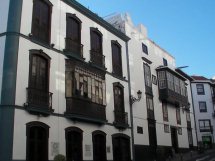More volcanos, this time on La Palma

PASSEPARTOUT
Christopher & Nirit Slaney
Wed 24 Nov 2010 18:54
|
Reluctantly we left La Gomera.
We really fell in love with that small volcanic Island.
We met people who came to La Gomera for a few days and stayed for two
years. It is the kind of place that grows on you.
We were going, but only after promising ourselves that
we would be back.
Unlike most of the cruising yachts, we plan to set off
for our crossing from La Gomera and not from Gran Canaria. The anchorage
at Valle Gran Rey is as charming as the main harbour of San Sebastian
where I plan to do our final provisioning.
And the mountains! We walked the volcanic slopes for hours and hours; all the more easier as the
island's bus service is geared up for dropping off and collecting
hikers.
But after a week it was time to explore another island
so we sailed to La Palma. Another volcanic island some 50 M north west of La
Gomera, and yet another pleasant surprise.
Santa Cruz, the capital, has kept it's charm as a
prosperous, Spanish colonial city. The woodwork on the balconies and the doors,
from hundreds of year ago is fascinating. The city has a glory to it.
Apart of the beautiful architecture add the
fact that the city is getting ready for Christmas and all the windows in the
shops are decorating with artificial snow, Santa dolls and such
like.
The streets are clean and elegant, full of small
cafes and
restaurants.
The marina itself, in the main city of Santa Cruz, is
nothing special. Certainly none of the marinas we have berthed in so far can
compete with what we are used to in the Mediterranean in places like Turkey and
France.
Our exploration of La Palma showed us an island
much more cultivated than La Gomera. Banana
plantations cover the northern side and a volcanic crater dominates the center.
We started our day with a 3 hour walk
in a forest which was almost jungle; full of life and loud with birdsong.
Running water was often heard but seldom glimpsed. We then drove up
to the rim of the crater along a well made but narrow switchback road into the clouds. Reaching the summit at around 2,500
meters it reminded me of Alpine ski slopes but without much chance of snow. The
original plan had been to hike around the rim but dense cloud cover made this
feel too spooky.
We did however sit on a rock, eat our lunch and listen
on the short-wave radio to yachts in the ARC fleet reporting their
midday positions. No word from Yossi Kol on WESTWIND, perhaps he's sailing
without a radio.
Ten gigantic telescopes built and supported
by universities and governments from all over the world dominate the
mountain top. Unfortunately they don't seem to have visiting hours as we would
have loved a peek inside.
We drove down few hundred meters to where the
visibility was better and walked on a different track.
The weather forecast is not great for tomorrow so we
staying another day. Might do the first part of our food shopping for the
crossing and work on the boat, or we could be tempted to go back into the
mountains.
Nirit. Tel +870 773 156 537 Follow us at http://blog.mailasail.com/psp2 |



